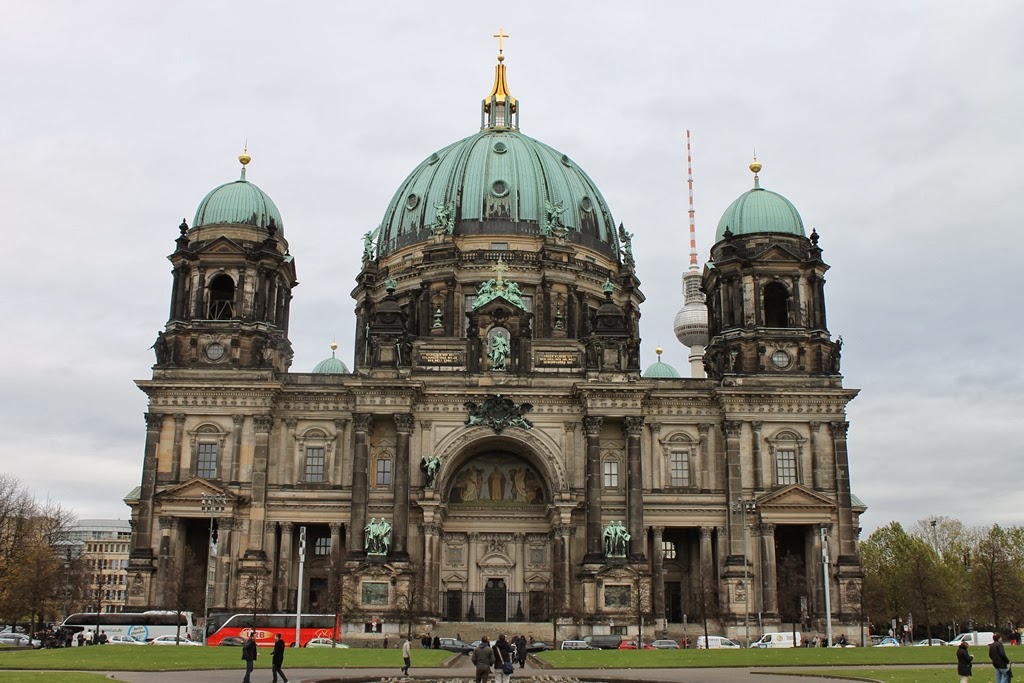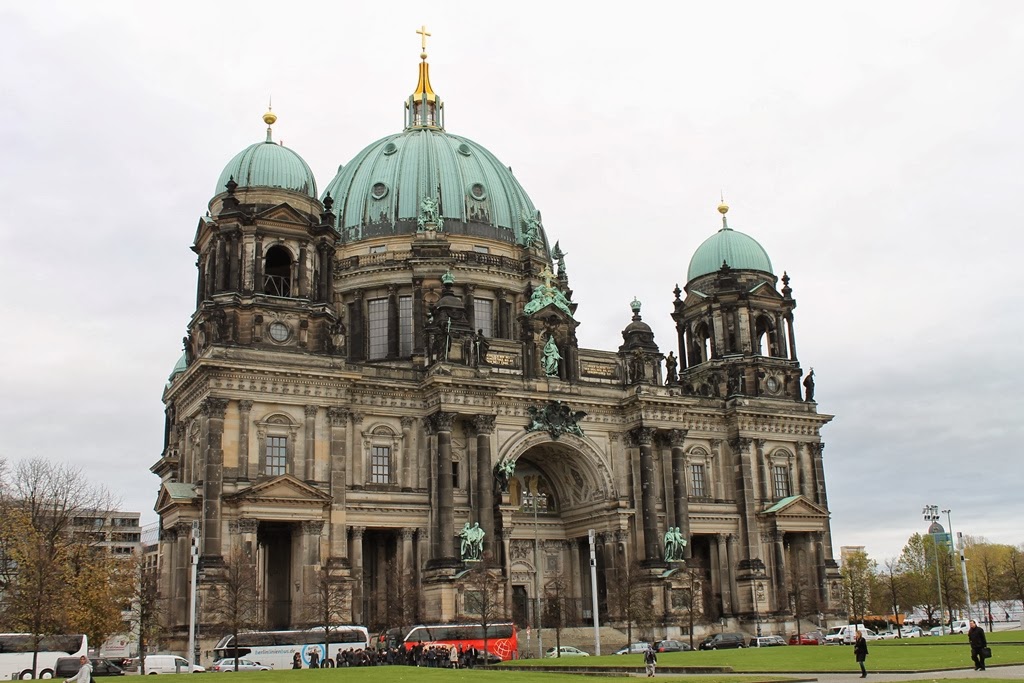I originally wanted to break up my posts by East and West, but there is way too much stuff in East Berlin to fit it all into one post. So today, I will go through more or less of what Luke and I did during our first few hours in Berlin. All sights in this post are located in East Berlin. Note: You may notice some pictures have different skies. That is because we walked down this street a few times during our trip.
{Berliner Dom}
We started around Brandenburg Gate and made our way East on Unter den Linden toward Alexanderplatz, which is about 1.7 miles. Unter den Linden is one of the main roads in Berlin, housing many embassies, the opera house, a university, and more.
{The whole area of this map is as far as ventured during our trip. The A to B line shows Brandenburg Gate to just after Alexanderplatz.}
Brandenburg Gate is one of the famous landmarks of Berlin. It is a huge arch that symbolizes unity in Berlin. On November 9, 1989, Berliners gathered here for the Festival of Freedom to celebrate the fall of the wall. All of these pictures are taken in Pariser Platz, the square on the front (east) side of the arch. (Vicki visited just two weeks before I did and got to see the Festival of Lights. Super cool!)Nighttime views of Brandenburg Gate
After continuing down Unter den Linden, we passed the Russian Embassy, a pretty impressive looking building (sorry no picture). Straying a few blocks south of the road is Gendermenmarkt. It is the home of twin cathedrals, German (left) and French (right), and also the Concert Hall (Konzerthaus) in the middle. Apparently, they were all rebuilt after the world to their original state.
Along the way back to Unter den Linden, we passed by a building that I have no idea what it is, but its scaffolding has been designed to look like the small portion on the left. I thought it was interesting as I am pretty sure that there is no building behind the scaffolding facade.
Back on Unter den Linden, we came upon the Opera House which was also covered in scaffolding (no picture sorry), but we didn't care. We were in search for a memorial located next to the building to remember the Nazi Book Burning - an "action against the un-German spirit" by the German Student Association. This hole in the ground shows a plain white room with empty book shelves.
Coming up on museum island and crossing the canal, the Berliner Dom was appearing in full view along with most of the Fernsehturm.
Throughout the city, we found several sites with outdoor exhibitions. The one next to the Berliner Dom was dedicated to the memory of the diverse population of Berlin in the 1920's who were persecuted and driven into exile under the Nazi Regime.
The Berliner Dom is Berlin's largest cathedral (although it is not actually a cathedral). Currently it is a Protestant church but it was consecrated as a Roman Catholic church in 1454.
Going a bit off path, a few more museums are just next to the cathedral on museum island. The Altes Museum (Old Museum) and the Alte Nationalgalerie (Old National Gallery) are both pictured, but the famous Pergamon and others are located here as well.
Heading back around the cathedral, we crossed the other side of the canal leaving museum island where the DDR Museum is located. We debated on visiting this museum, but reviews didn't make it seem worth our time.
Now, we have basically reached Alexanderplatz. In this picture below, you will see pink pipes. These pipes (sometimes pink, purple, red and blue) run all over the city. Apparently, Berlin is built on a swamp and these pipes suck water out of the ground for building construction, and then the water is drained into the canals. Anyway, I have no idea what the building in this picture is. Anyone???
Below is the steeple of Marienkirche (St. Mary's Church) which has the tallest tower in Berlin. And we also have the Fernsehturm (TV Tower).
But first, let's head south just a little bit where in my opinion was the most Germany-like area of Berlin. Nikolaikirche (St. Nicolas' Church) is somewhat hidden in the buildings, but it still stands tall enough to see from a distance. And we just so happened to walk upon it while its bells were chiming. Like I said, I got a very German-like vibe here as there many traditional German restaurants and the architecture looked German. Since Berlin is practically new, it doesn't feel much like Germany. (Sorry for the terrible grainy picture - iPhone photo.)Now... the Fernsehturm... Built in 1965-69, it is the tallest structure in Germany at 368 meters and can be seen throughout most of the city at all times of the day. At night, it can appear to be shooting light beams giving it a nickname of a Death Star.
In Alexanderplatz, there is a Weitzeituhr (world clock) with 24 faces corresponding to the 24 time zones. I had absolutely no clue how to read this thing! But what we found most interesting was that for the Central Time Zone city, instead of using Chicago or Dallas or even Houston, they used New Orleans! Who dat!!!?
That pretty much concludes our walk from Brandenburg Gate toward Alexanderplatz. It was dark by the time we reached Alexanderplatz on our first day... not that we took forever but because it got dark at 4:30pm. In the evenings, we found Alexanderplatz to be the hang out for young folks with fast food joints, shopping and a wide open space to cause a ruckus.
We walked just a few feet away from the square and determined that liters of beer at Hofbrauhaus appealed to us much more than obnoxious teen-land. Will you join me for a dunkel?
RANDOM FACT:
November 9th is a big date in German history not just because of the fall of the Berlin Wall. During a tour, we learned of several events. Read about them on Wikipedia. Remember, Remember, the 9th of November. :-)

Click here to learn how to comment using Disqus.






























No comments:
Post a Comment